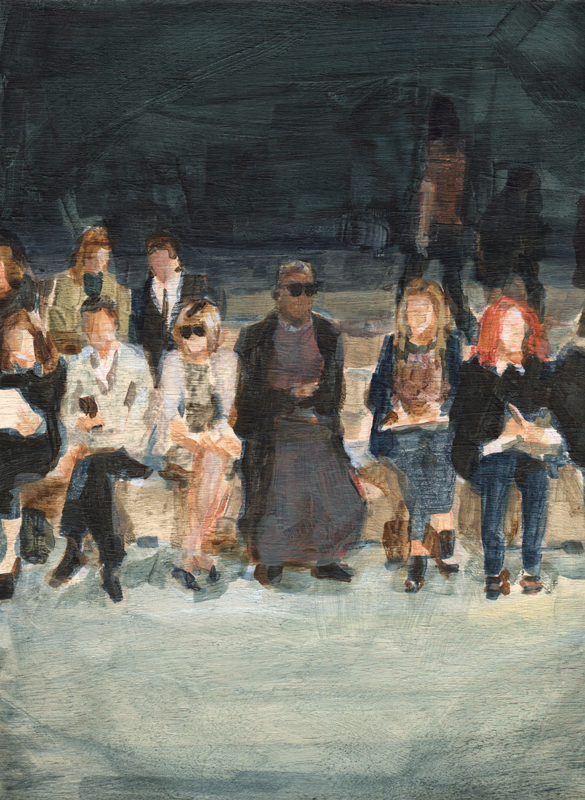All I know is that the hours are long, under these […] proceedings which – how shall I say – which may at first sight seem reasonable, until they become a habit. You may say it is to prevent our reason from foundering.
Samuel Beckett, Waiting For Godot
CATWALK SHOWS HARDLY EVER begin on time. Delay, anticipation and deferment are traditionally part of the routine. Waiting for the show to begin is, in other words, an integral part of the experience of the catwalk show as a live event. But time is precious and waiting not only exemplifies anticipation, but also holds an explicit value in itself. The time spent waiting for a catwalk show to start can be described as liminal, a moment that implies transition or passing from one state to another. In the age of information technology and instant image production, waiting – as both process and ritual – is, however, a rare occurrence. The philosopher Harold Schweizer argues that waiting can be regarded as a ‘temporary liberation from the economics of time-is-money, as a brief respite from the haste of modern life’.1 While delayed catwalk shows during the otherwise hurried catwalk season are often considered unprofessional if not rude, waiting can also be seen as a privilege reserved for the small elite attending such events. In this context, the idea of liminal time marks an important aspect of the fashion cycle. As a threshold it implies the experience of a shift from one phase to another.
When exploring the role of liminal time in the context of contemporary fashion shows, its absence within the digital frame is noteworthy. Limitless reproductions of catwalk shows have in recent times altered the experience of the live event, which is arguably no longer rooted within liminal space and time. Recently, the purpose and currency of the live event and ideas of temporality have gained renewed attention in fashion writing. Sociologist Agnès Rocamora’s detailed discussion of fashion and time in relation to new technologies and the proliferation of digital platforms is especially vital for exploring the constant acceleration within the symbolic production of fashion. Rocamora argues that with the instant ‘production of images, fashion has become more immediate’ and that the speed with which fashion discourse is produced challenges the hegemonic position of high fashion.2 What is of relevance when we discuss fashion’s relationship with time is how cultural forms such as the catwalk show are tested through constant acceleration of live streams and instant messaging on fashion media platforms or social media. In this regard, Rocamora refers to Paul Virilio’s seminal essay ‘The Overexposed City’. Here the French cultural theorist speaks of ‘real time’ being replaced by virtual time which exposes ‘itself instantaneously’.3 Yet physical space still holds meaning in the light of liminal time. The moment leading up to a catwalk show is hardly ever replicated online and in this sense the virtual world has not replaced the ‘real’. Instead, the digital representation of the live event has lost its threshold, as the stream begins the instant the model enters the runway.
The actual waiting, suspension and delay are only experienced or endured by the elite that is present at the show. This marks what can be called ‘real time’. In order to measure duration in time, the philosopher Henry Bergson famously observed a lump of sugar dissolving in water. His aim was to prove that our notion of time relates to our own, subjective understanding. Time spent waiting is informed through our lived experience, such as feelings of impatience or frustration, and not by what he describes as ‘mathematical time’.4 But in a postmodern context, time as well as consciousness is mobile and notions of duration incomplete. Time flows at different speeds and the instance of delay becomes a manifestation of the structure of the catwalk show, the ritual of waiting contextualising not only the reality of the live event, but also the reversal of social structures.
According to the anthropologist Victor Turner liminal time can be seen as a passage or pathway that is culturally defined.5 Turner refers to ritual in relation to structural positions, which govern behavioural as well as institutional processes. His position differs from that of anthropologist Claude Lévi-Strauss, who differentiates between the social and the ritual as two separate entities.6 Rather than making this distinction, Turner defines liminality as a time or space in which ‘normal modes of social action’ are scrutinised or challenged. The idea of liminal time as a transitional stage is also described as ‘neither here nor there’, or as Turner puts it: ‘betwixt’ – a stage between separation and reassimilation.7
In his biography Dior by Dior, designer Christian Dior describes the moment of waiting for the live event as filled with anticipation; a stage before those on and off the catwalk come together:
‘Half an hour before the show, two people are seated comfortably side by side on each step; but twenty minutes later, they disappeared beneath a sea of new arrivals. The staircase begins to look like an overloaded boat.’8
Agoera is a Japanese illustrator and artist.
Nathalie Khan is a researcher and visiting lecturer at Sotheby’s and NYU, and the course leader at Central Saint Martins’ Culture, Criticism and Curation.
H Schweizer, On Waiting, Routledge, London, 2008, p.2 ↩
A Rocamora, ‘New Fashion Times: Fashion and Digital Media’, in S Black (ed.), The Handbook of Fashion Studies, Bloomsbury, London, 2013, pp.61–77 ↩
P Virilio, ‘The Overexposed City’, in Lost Dimension, MIT Press, New York, 2012 ↩
H Bergson, Creative Evolution, Dover Publications, Mineola, NY, 1998 [1st ed.1911], pp.9–10 ↩
V Turner, ‘Humility and Hierarchy: The Liminality of Status Elevation and Reversal’, in The Ritual Process: Structure and Anti-Structure, Aldine Transaction, New York, 1997 [1st ed.1969], pp.166–194 ↩
C Lévi-Strauss, Structural Anthropology, Basic Books, London, 1974 ↩
V Turner, ‘Rites of Passage’, in The Forest of Symbols, Cornell University Press, Ithaca, 1967, pp.96–102 ↩
C Dior, Dior by Dior, Penguin, London, 1957, p.106 ↩
